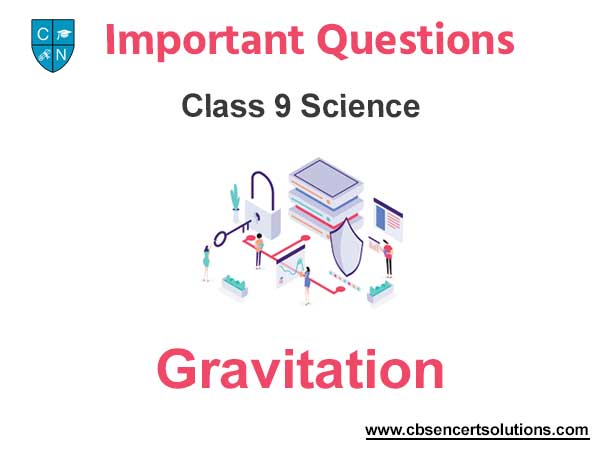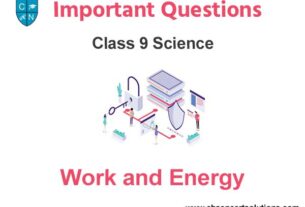Students can read the important questions given below for Gravitation Class 9 Science. All Gravitation Class 9 Notes and questions with solutions have been prepared based on the latest syllabus and examination guidelines issued by CBSE, NCERT and KVS. You should read all notes provided by us and Class 9 Science Important Questions provided for all chapters to get better marks in examinations. Science Question Bank Class 9 is available on our website for free download in PDF.
Important Questions of Gravitation Class 9
Question. An object is put one by one in three liquids having different densities. The object floats with 1/9, 2/11, and 3/7 parts of their volumes of outside the liquid surface in liquids of densities d1, d2 and d3 respectively. Which of the following statement is correct?
(a) d1> d2> d3
(b) d1> d2< d3
(c) d1< d2> d3
(d) d1< d2< d3
Answer
D
Question. The value of acceleration due to gravity
(a) is same on equator and poles
(b) is least on poles
(c) is least on equator
(d) increases from pole to equator
Answer
C
Question. Two objects of different masses falling freely near the surface of moon would
(a) have same velocities at any instant
(b) have different accelerations
(c) experience forces of same magnitude
(d) undergo a change in their inertia
Answer
A
Question. The gravitational force between two objects is F. If masses of both objects are halved without changing distance between them, then the gravitational force would become
(a) F/4
(b) F/2
(c) F
(d) 2 F
Answer
A
Question. The weight of an object at the centre of the earth of radius R is
(a) zero
(b) infinite
(c) R times the weight at the surface of the earth
(d) 1/R2 times the weight at surface of the earth
Answer
A
Question. Law of gravitation gives the gravitational force between
(a) the earth and a point mass only
(b) the earth and Sun only
(c) any two bodies having some mass
(d) two charged bodies only
Answer
C
Question. A boy is whirling a stone tied with a string in an horizontal circular path. If the string breaks, the stone
(a) will continue to move in the circular path
(b) will move along a straight line towards the centre of the circular path
(c) will move along a straight line tangential to the circular path
(d) will move along a straight line perpendicular to the circular path away from the boy
Answer
C
Question. In the relation F= G M m/d2, the quantity G
(a) depends on the value of g at the place of observation
(b) is used only when the earth is one of the two masses
(c) is greatest at the surface of the earth
(d) is universal constant of nature
Answer
D
Question. The atmosphere is held to the earth by
(a) gravity
(b) wind
(c) clouds
(d) earth’s magnetic field
Answer
A
Question. An apple falls from a tree because of gravitational attraction between the earth and apple. If F1 is the magnitude of force exerted by the earth on the apple and F2 is the magnitude of force exerted by apple on earth, then
(a) F1 is very much greater than F2
(b) F2 is very much greater than F1
(c) F1 is only a little greater than F2
(d) F1 and F2 are equal
Answer
D
Question. The force of attraction between two unit point masses separated by a unit distance is called
(a) gravitational potential
(b) acceleration due to gravity
(c) gravitational field
(d) universal gravitational constant
Answer
D
Question. Two particles are placed at some distance. If the mass of each of the two particles is doubled, keeping the distance between them unchanged, the value of gravitational force between them will be
(a) ¼ times
(b) 4 times
(c) ½ times
(d) unchanged
Answer
B
Question. An object weighs 10 N in air. When immersed fully in water, it weighs only 8 N. The weight of the liquid displaced by the object will be
(a) 2 N
(b) 8 N
(c) 10 N
(d) 12 N
Answer
A
Question. The value of quantity G in the law of gravitation
(a) depends on mass of earth only
(b) depends on radius of earth only
(c) depends on both mass and radius of earth
(d) is independent of mass and radius of the earth
Answer
D
Question. A girl stands on a box having 60 cm length, 40 cm breadth and 20 cm width in three ways. In which of the following cases, pressure exerted by the brick will be
(a) maximum when length and breadth form the base
(b) maximum when breadth and width form the base
(c) maximum when width and length form the base
(d) the same in all the above three cases
Answer
B
Question. What is the source of centripetal force that a planet requires to revolve around the Sun? On what factors does that force depend?
Answer. Gravitational force. This force depends on the product of the masses of the planet and sun and the distance between them.
Question. Two objects of masses m1 and m2 having the same size are dropped simultaneously from heights h1 and h2 respectively. Find out the ratio of time they would take in reaching the ground. Will this ratio remain the same if (i) one of the objects is hollow and the other one is solid and (ii) both of them are hollow, size remaining the same in each case? Give reason.
Answer.

Ratio will not change in either case because acceleration remains the same. In case of free-fall acceleration does not depend upon mass and size.
Question. On the earth, a stone is thrown from a height in a direction parallel to the earth’s surface while another stone is simultaneously dropped from the same height. Which stone would reach the ground first and why?
Answer. Both stones will take the same time to reach the ground because the two stones fall from the same height.
Question. Identical packets are dropped from two aeroplanes, one above the equator and the other above the north pole, both at height h. Assuming all conditions are identical, will those packets take same time to reach the surface of earth. Justify your answer.
Answer. The value of ‘g’ at the equator of the earth is less than that at poles. Therefore, the packet falls slowly at equator in comparison to the poles. Thus, the packet will remain in air for longer time interval, when it is dropped at the equator.
Question. The weight of any person on the moon is about 1/6 times that on the earth. He can lift a mass of 15 kg on the earth. What will be the maximum mass, which can be lifted by the same force applied by the person on the moon?
Answer. Since the weight of any person on moon is about 1/6 times that on the earth, hence acceleration due to gravity at moon is 1/6 of that on earth. This means that by applying the same force a person can lift six times heavier object on the moon than what he could lift on the earth. So, the maximum mass which can be lifted by the same force applied by the person on the moon is 6 × 15 kg = 90 kg.
Question. Suppose gravity of earth suddenly becomes zero, then in which direction will the moon begin to move if no other celestial body affects it?
Answer. The moon will begin to move in a straight line in the direction in which it was moving at that instant because the circular motion of moon is due to centripetal force provided by the gravitational force of earth.
Question. How does the weight of an object vary with respect to mass and radius of the earth. In a hypothetical case, if the diameter of the earth becomes half of its present value and its mass becomes four times of its present value, then how would the weight of any object on the surface of the earth be affected?
Answer. Weight of an object is directly proportional to the mass of the earth and inversely proportional to the square of the radius of the earth. i.e.,
Weight of a body ∝ M/R2
Original weight = W0 = mg = mG M./R2
When hypothetically M becomes 4 M and R becomes R/2

Question. Calculate the average density of the earth in terms of g, G and R.
Answer.

Question. How does the force of attraction between the two bodies depend upon their masses and distance between them? A student thought that two bricks tied together would fall faster than a single one under the action of gravity. Do you agree with his hypothesis or not? Comment.
Answer. Answer. F ∝ m1m2 and F ∝ 1/d2
This hypothesis is not correct. The two bricks, like a single body, fall with the same speed to reach the ground at the same time in case of free-fall. This is because acceleration due to gravity is independent of the mass of the falling body.
Question. The earth is acted upon by gravitation of Sun, even though it does not fall into the Sun. Why?
Answer. The gravitational of the sun provides the necessary centripetal force to keep the earth in its orbit. This counters the centrifugal force which arises due to circular motion of the earth. Thus, earth remains on its orbit without either falling into the sun or going away tangentially to its orbit.
Question. (a) A cube of side 5 cm is immersed in water and then in saturated salt solution. In which case, will it experience a greater buoyant force. If each side of the cube is reduced to 4 cm and then immersed in water, what will be the effect on the buoyant force experienced by the cube as compared to the first case for water. Give reason for each case.
(b) A ball weight 4 kg of density 4000 kg m-3 is completely immersed in water of density 103 kg m-3. Find the force of buoyancy on it. (Given g = 10 ms-2.)
Answer. (a) (i) The cube will experience a greater buoyant force in the saturated salt solution because the density of the salt solution is greater than that of water.
(ii) The smaller cube will experience lesser buoyant force as its volume is lesser than the initial cube.
(b) Buoyant force = weight of the liquid displaced
= density of water × volume of water displaced ×g
= 1000 x 4 / 4000 x 10 = 10N



